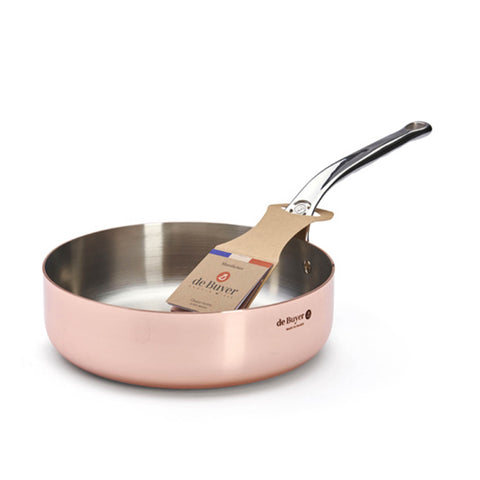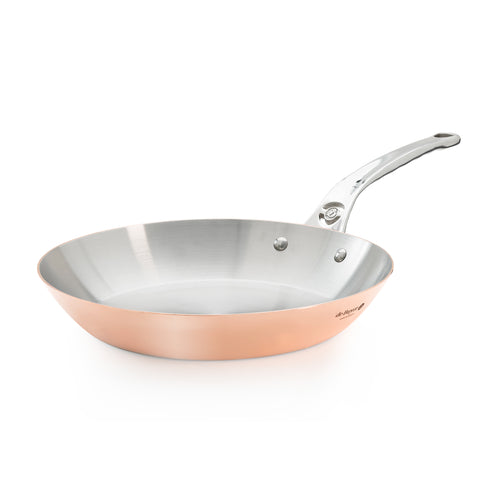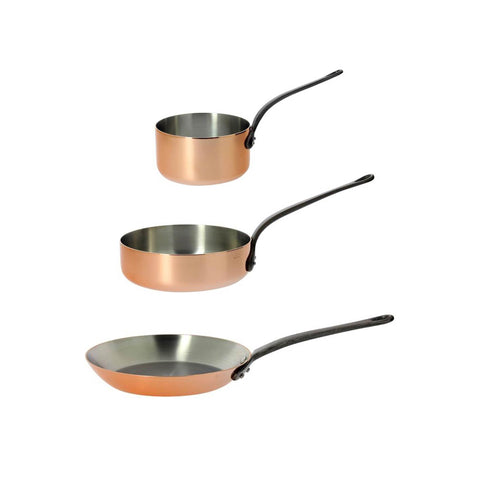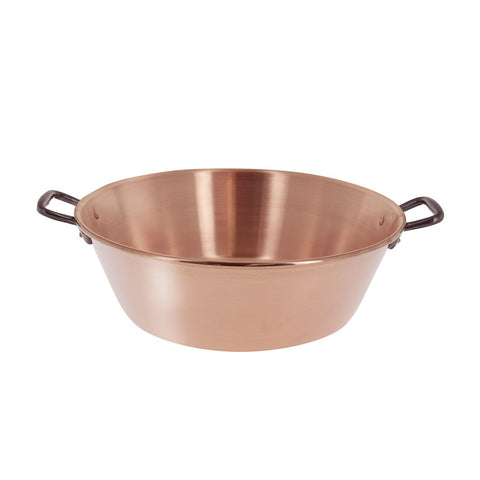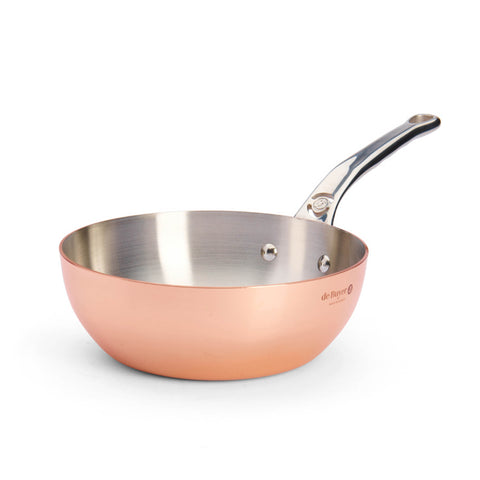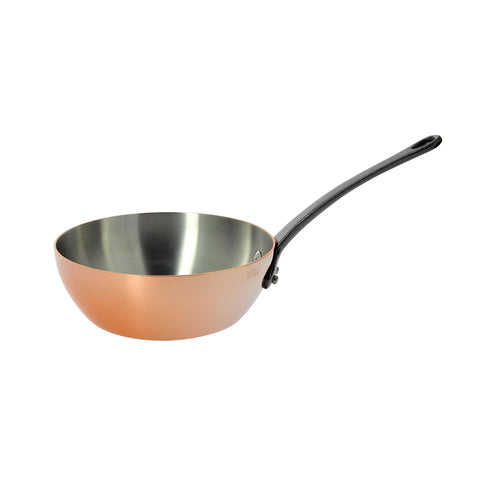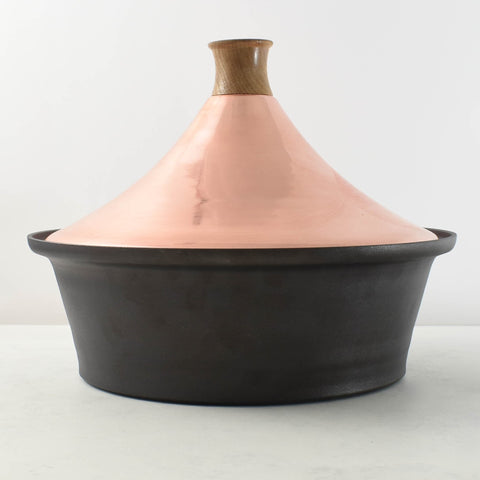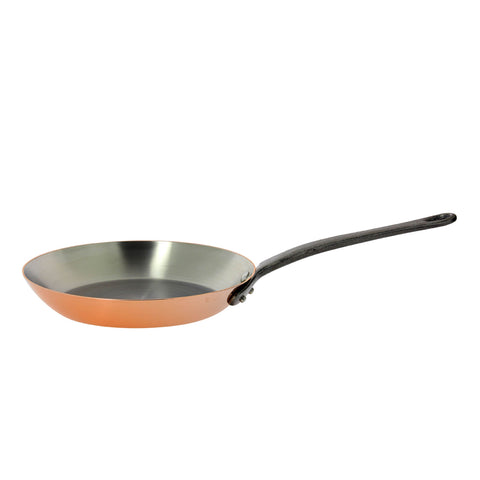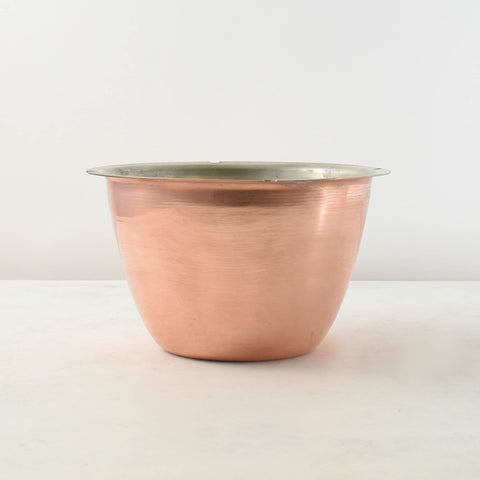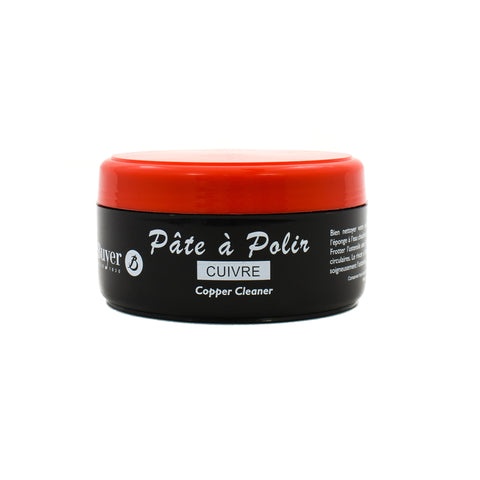The Buyer’s Guide to Copper Pans - Everything You Need To Know Before You Buy
by Kristin Lohse

Discover everything you need to know about copper pans, in our comprehensive buyer’s guide. And find out what you should be asking, before you buy your dream copper pan set.
Sous Chef’s cookware and pan experts:
In this guide, you’ll hear from Sous Chef buyer Kristin Lohse, who has many years of cookware experience. Sourcing, testing and reviewing the very best cookware, from some of the world’s best kitchens. Plus food editor Holly Thomson, who spent several years as a shopping writer, reviewing cookware and pans for BBC Good Food Magazine.
In this guide we’ll cover:
- What are copper pans
- How can you tell if copper cookware is real
- What are the different types of copper pans
- What to cook in a copper pan
- What NOT to cook in a copper pan
- What are the best copper pots and pans
Shop all copper pans here, and learn more about cooking with copper on induction hobs.
What are copper pans?
A copper pan excels in heat distribution. It heats up fast and cools down quickly. This makes it ideal for cooking sauces or tempering chocolate. And it's not just about function; these pans add beauty to any kitchen.
They come in various types, like the classic sauté pan or a jam-making pan. Each type serves a specific purpose. For example, a copper frying pan is perfect for achieving an even cook on meats and vegetables.
Copper pans respond almost instantly to changes in temperature, giving you great control over your cooking. The thick base of a copper pan means there is extremely even heating with no hot spots - great for consistent results, every time you cook.
Why choose a copper pan?
- Copper is very heat responsive and will heat up and cool down quickly when you adjust the power on your hob for precision cooking.
- Another benefit of the heat responsiveness is that since the pan heats up quickly, you will also use less energy.
- Since copper is a very good conductor of heat, you will get very even heat distribution through the entire pan.
- Tin is naturally a very non-stick material, and is easy to clean
Are copper pans 100% copper
No. Copper pans are not usually 100% copper. The reason is simple: pure copper is too reactive with food. This can affect both the food's taste and colour. To combat this, most copper cookware is lined with another metal.
- Stainless steel is a common choice. It's durable and doesn't react with food.
- Some more traditional pans might use tin lining. Tin is softer than stainless steel and requires more care. But it is naturally non-stick, and easy to clean.
Are copper pans better than stainless steel
Choosing between copper and stainless steel pans depends on your cooking needs.
- Copper pans offer superior heat distribution. They heat up and cool down quickly, making them ideal for temperature-sensitive dishes like sauces or chocolates. For example, a copper saucepan can help you achieve the perfect simmer for your sauce without scorching.
- Stainless steel pans, on the other hand, are champions of durability. They resist scratches, dents, and corrosion. This makes them suitable for everyday cooking with minimal special care.
Modern stainless steel-lined copper pans offer the best of both worlds. They can withstand high temperatures, just as stainless steel can.
Maintenance is another factor. Copper pans require polishing to maintain their shine and prevent tarnishing. Stainless steel is low-maintenance, retaining its appearance without extra work.
Do chefs like copper pans?
Yes, many chefs favour copper pans for their superior heat control. This feature allows for precise temperature adjustments, essential in professional kitchens. For dishes requiring exact heat, like delicate sauces or perfectly seared meats, copper is the go-to. Its ability to evenly distribute heat prevents hot spots, reducing the risk of burning or uneven cooking.
Copper's responsiveness to temperature changes is unmatched. This means chefs can quickly go from a simmer to a boil or vice versa without moving the pan off the burner. Such versatility is crucial in a fast-paced kitchen environment.
Copper can also require more maintenance. They need regular polishing to maintain their original shine. However, you may prefer the tarnished look - in which cae, polishing is optional! This upkeep is often seen as worth the effort for the performance they deliver.
How long do copper pans last?
In terms of durability, copper pans can last a lifetime if cared for properly. Typically, a high-quality copper pan will last for 20 to 30 years or more.
The lifespan greatly depends on the type of lining used and the care the pan receives. For example, pans lined with tin might need re-tinning every few years if used heavily, whereas those lined with stainless steel generally last longer without needing such maintenance.
Kristin says: “You can most likely hand down your copper pans through generations. Even traditional tin-lined copper pans can be handed down in generations. They will just need to be relined every now and then when the tin is getting too worn or overheated.”
How can you tell if copper cookware is real
To verify if copper cookware is genuine, check its colour and weight.
- Real copper has a distinct, bright reddish-orange hue that changes to a brownish colour when oxidised. If the pan shows a pinkish tint, it might be a blend, often aluminium or another metal, simply coated with copper.
- The weight of the cookware is another indicator. Genuine copper pans are notably heavier than faux copper pieces. When you lift a real copper pan, the substantial heft should be apparent.
- Conductivity tests also help. Since copper is an excellent conductor of electricity, you can test its authenticity by checking how quickly it heats up. Real copper will heat evenly and rapidly.
- Lastly, look for a hallmark or a maker’s mark, usually stamped on the base or handle. Reputable manufacturers will mark their cookware to certify its composition.
What are the different types of copper pans?
There’s a copper pan for all your cooking needs, whether you’re sauteing vegetables, searing meat, or slow cooking a rich beef ragu. Our copper pan range includes casserole pans, saute pans, frying pans, jam pans and more! Read on for the best copper pans to buy.
What to cook in a copper pan
Copper pans are excellent for dishes that require precise heat management. Here's a list of foods that are ideally cooked in copper cookware:
- Sauces: Make smooth, creamy sauces like hollandaise without overheating.
- Jams: Prepare fruit jams, as copper promotes quicker evaporation.
- Seafood: Sear scallops and fish to perfection, ensuring a crisp exterior with a moist interior.
- Caramel: Cook caramel to just the right temperature without crystallisation.
- Eggs: Scramble or fry eggs; the pan's even heat prevents sticking and overcooking.
- Polenta: Stir polenta smoothly with consistent heat, avoiding lumps.
- Chocolate: Melt chocolate evenly for desserts and toppings.
Copper's superior conductivity means these foods cook more evenly. Heat spreads across the pan's surface without hot spots, making it easier to achieve desired cooking results. This feature is particularly beneficial for dishes that need gentle and controlled heat, ensuring that everything from sauces to seafood is cooked just right. Whether you're melting, simmering, or searing, a copper pan can handle it with precision.
What NOT to cook in a copper pan
Generally, you can cook anything in a lined copper pan (lined with stainless steel, ot tin). You may occasionally find an unlined copper pan - perhaps for specific patisserie work with caramel and sugar. An unlined copper pan is a little more delicate, and you should avoid very acidic food:
- Avoid tomatoes, citrus, and vinegar-based sauces, as they can react with copper, leading to metallic flavours and potentially ingesting copper.
But these restrictions only generally apply to unlined copper pans. Many copper pans on the market are lined with other metals like tin or stainless steel, which prevent these reactions. Always check if your copper pan is lined before cooking these types of foods to ensure both safety and quality of your dishes.
What are copper pans used for
Copper pans are celebrated for their exceptional thermal conductivity, making them particularly well-suited for precision cooking. What are copper pans best for? They excel in tasks where temperature control is crucial. Here’s a brief overview of their ideal uses:
- Sauces: Perfect for making delicate sauces that require gentle, even heat to avoid curdling.
- Sautéing vegetables: Rapid heating helps in sautéing vegetables quickly, preserving their crunch and colour.
- Simmering: Great for dishes that need to simmer for extended periods, maintaining a consistent temperature throughout the cooking process.
- Seafood: Excellent for cooking seafood, providing quick heat adjustments to achieve a crisp exterior without overcooking the delicate interior.
What are the best copper pots and pans
Choosing the best copper pots and pans depends on several key factors. These cookware items are lauded for their superior heat conductivity and precise temperature control, making them favourites among both professional chefs and home cooking enthusiasts. Below are the best copper pots and pans that we have here on Sous Chef:
Sauté pan
Use the De Buyer Prima Matera sauté pan for gravy, browning meat, and sautéing vegetables. Its copper construction heats fast and conducts well, enhancing your cooking. The pan’s low, straight sides make it perfect for sauce reduction and juice caramelisation. Its stainless steel handle is angled for safety, keeping your hands clear of hob heat.
Frying pan
The De Buyer Inocuivre copper frying pan, with its stainless steel interior, is both functional and elegant. Use it to fry vegetables, sear meat, or flambé fruit for crêpes. Drawing on traditional French design, this pan replaces tin with stainless steel for durability. It features a Lyonnaise shape with high, rounded sides that prevent food from sticking and facilitate easy transfer from pan to plate.
Constructed with 90% copper, this pan offers superior heat control. The 10% stainless steel interior ensures longevity without the need for re-tinning.
Copper pan set
The De Buyer Ultimate Induction Pan Set is ideal for anyone with an induction hob. This luxury set is a perfect gift choice and includes three exceptional pans:
- De Buyer Prima Matera Induction Copper Saucepan (14cm): Perfect for small tasks like making caramel or sauces.
- De Buyer Prima Matera Induction-Compatible Copper Sauté Pan: A versatile all-rounder for browning meat, reducing sauces, and caramelizing onions.
- De Buyer Prima Matera Induction Copper Frying Pan: Excellent for searing steaks, this pan heats up quickly and maintains its temperature. Its high sides are also ideal for preparing sauces as your steak rests.
Saucepan
Netherton Foundry copper saucepans combine beauty with versatility and durability. They feature a polished copper exterior and a tin lining, which heats quickly and evenly for reliable, professional cooking results. The tin lining is non-stick, guarding against corrosion and damage from acidic foods. These pans provide excellent temperature control, making them ideal for crafting superb sauces, soups, and gravies.
Jam pan
The De Buyer solid copper jam pan is a top choice for small batch jam makers globally. Copper's quick response to temperature changes prevents overcooking, as it doesn't retain heat long after removal from heat. Additionally, copper helps maintain the natural color of fruits, ensuring your strawberry jam remains a bright red, rather than turning a mushy brown.
Saucier
Use the De Buyer Prima Matera copper saucier for sweet and savory sauces, reducing gravies, and sautéing vegetables. Its high curved sides make it versatile for all stove types, including induction. Favored by professional chefs for its responsiveness and excellent temperature control, this elegant pan features a small base for quick heating and a wider top for easy stirring. The durable stainless steel riveted handle also allows for oven use.
Which is the best copper pan to buy?
Best copper pan for cooking sauces
The De Buyer Prima Matera conical copper saute pan is essential for cooks who make lots of sauces, gravies and jus. The shape of the pan allows for fast, efficient reduction of sauces. Conical saute pans are also popular for anything that might need a lot of stirring - making custards, risottos, even fudge!
Best copper pan for making North African dishes
The base of the tagine is made from Netherton’s signature heavy duty spun iron and has a 4 litre capacity - ideal for feeding a crowd. It has a smooth, flat base which heats up evenly and can be used on range, gas, electric and induction hobs. The bowl is pre-seasoned with flax oil so you can start cooking right away!
Tagines were traditionally used as portable ovens, letting people cook and carry food as they travel. The funnel-style lid lets steam rise, condense, then fall back, keeping your ingredients moist and tender.
Best copper pan for searing meat
The De Buyer Prima Matera copper frying pan is ideal for searing two good-sized steaks (or other high temperature cooking), plus its high sides mean while the steak is resting, you can make a sauce in the same pan.
Best copper pan for all round cooking
Netherton Foundry’s copper prospector pan is a beautiful and versatile addition to your cookware collection. With its polished copper exterior and traditional tin lining, it offers fantastic temperature control and even heat distribution. You can use this double-handled pan to fry on the hob or bake in the oven.
Tin lined copper pans have been used in restaurant kitchens since the 17th century and remain a popular choice for professional chefs and keen home cooks. With proper care, they will last for years and become a firm favourite in your kitchen
Best copper pan for making jam
Pans like the De Buyer solid copper jam pan are favoured by small batch jam makers all over the world. Copper reacts to changes in temperature almost instantly. This means you can avoid overcooked jam caused by the pan staying hot for a long time, even after being removed from the heat.
Best copper pan for making steamed puddings
Use Netherton Foundry’s copper pudding mould to create delicious sweet and savoury puddings. It’s the perfect size for making a steak and ale pudding to serve with rich, glossy gravy. Alternatively, satisfy your sweet tooth with a zesty lemon sponge or indulgent sticky toffee pudding.
The heavy duty spun copper pudding pot has a tin lining to protect it from acidic foods and prevent flavour tainting. There are four indentations cut into the top rim to ensure that the string used to retain the parchment paper remains in place. The paper is used to cover the pudding to keep it dry when placed in the boiling pan.
Frequently Asked Questions
What are the best copper cookware brands?
At Sous Chef, we love De Buyer copper cookware. De Buyer’s Inocuivre range combines traditional design with modern materials. The inocuivre copper pans are made of 90% copper and 10% stainless steel. Copper on the outside provides the pan with excellent control, while the stainless steel inside eliminates the need for re-tinning.
De Buyer’s Prima Matera copper pan range is the collection to choose if you have an induction hob. Copper doesn’t often work on induction, so De Buyer has included a thin stainless steel plate at the base to give it great induction performance. The riveted cast iron handles on this range guarantee durability, but also keep cooler than other metal handle materials when cooking on the hob.
Is copper cookware the best?
Copper cookware offers superb results thanks to its tremendous heat conduction - it heats up quickly and cools down quickly. This is great for making confectionery such as caramels, fudge and chocolate work, where the temperature needs to be very well-controlled.
However, copper cookware is a commitment as it needs to be very well-cared for. If you want a pan that is easy to clean, opt for stainless steel. If it’s the fantastic heat retention you want, cast iron is another option to consider.
How should I care for my copper pans?
Copper is a very soft metal, so it scratches easily. The bases of all copper pans may already have slight scratches from the final polishing process. To minimise new scratches, try not to drag the pan across surfaces (e.g. from one part of your work surface to another).
To avoid warping, do not plunge your copper pans into very hot water or vice versa. Copper will develop a patina over time. To restore its warm glow, use a copper polishing paste from time to time. Hand wash copper pans with warm, soapy water, and use white vinegar to remove traces of oxidation and fats on the inside of the pan.
Other top tips for caring for your pan:
- Copper is not dishwasher safe, so should be washed in warm soapy water with a non-abrasive sponge or cloth. Rinse and dry thoroughly before storing.
- Avoid scouring pads and metal utensils which will scratch the lining. Wood or silicone utensils are the best option.
- Don't leave the pans on the hob with nothing in them
- If using in the oven, it is best not to go above 180ºC / 356ºF.
Shop all copper pans here, and read our guide to saute pans here.

About the author
Kristin is the Purchasing and Buying assistant at Sous Chef. She has several chefs and excellent home cooks in her family, and grew up in the kitchen in Sweden. Cooking and baking with her mum happened pretty much every day. Cinnamon rolls were always stocked up in the freezer, and if they were running low, more baking had to be done. Kristin always loves learning more about food and ingredients to continue improving her skills.
